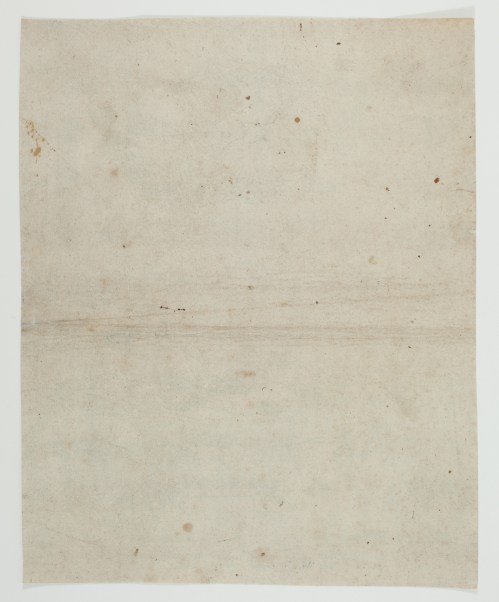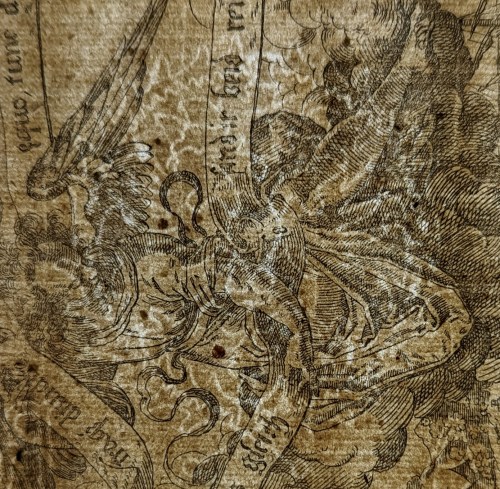Christoph MURER: Allegory on Fortune and Happiness - 1596
SOLD
Etching, 242 x 195 mm to the borderline. Bartsch 2, Nagler 4, Andresen 7, Hollstein 26, 2nd state (of 2).
Impression of the 2nd state (of 2), with Elias Wöllhöffer excudit.
Very fine impression printed on laid watermarked paper (double-headed eagle with letters A and R). Thread margins on all sides around the borderline. A few small brown spots in the subject, usual horizontal drying fold, otherwise in very good condition.
Very rare. Adam Bartsch already noted: "The few pieces that he etched have become very rare". (Bartsch, p. 384, translated by us)
Thea Vignau-Wilberg notes that “in 1596, [Murer] created the etched allegory Mut ohne Gut, Gut ohne Mut, in which a rich, grief-stricken merchant and a poor, fun-loving youth face each other. Like other Murer prints, it was to serve as a model for the decorative arts." (Christoph Murer, p. 29, translated by us). « Ebenfalls 1596 entstand die radierte Allegorie Mut ohne Gut, Gut ohne Mut, bei der ein reicher, kummervoller Kaufmann und ein armer, lebensfroher Jüngling einander gegenüberstehen. Sie sollte, wie auch andere Murer-Graphik, als Vorlage für das Kunstgewerbe dienen.“
Christoph Murer or Maurer was a stained-glass painter, printmaker and draughtsman. As a printmaker, he is best known for his series of etchings Emblemata Miscella Nova (Hollstein 84) and his woodcut illustrations. He also produced a number of isolated prints, including several allegories: Allegory on Ambition (Hollstein 25, an impression of which is preserved in Munich), Allegory on Painting (Hollstein 27), which is described by Andresen but no impression of which is currently located. L'Indigent et le richard belongs to this register of allegorical works.
The engraving is signed CMurer Fecit lower left and located Tiguri, i.e. Zurich, Murer's home town. The title varies from catalogue to catalogue. L'Indigent et le richard [The Poor and the Rich] is the title given by Bartsch, while in the Hollstein series, Robert Zijlma calls it Allegory on Fortune and Happiness. Andresen's catalogue, followed by Thea Vignau-Wilberg, refers to it by the German part of the caption etched at the bottom: Mut ohne Gut, Gut ohne Mut [Energy without Wealth, Wealth without Energy].
This caption divides the image into two parts, each corresponding to one of the two main characters. On the left is a young man, whose poverty can be seen in the condition of his shoes: he has almost nothing, but he is full of spirit, as he proclaims: Nulli sunt num(m)i, sed sunt mihi gaudia multa [I have no riches, but I have much joy]. On the right, an old man seated at a table, appearing to have fallen asleep while counting his wealth in front of a thick open register, says the opposite: Multi sunt nu(m)i, sed sunt mihi gaudia nulla [I have much wealth, but I have no joy]. The background illustrates this antithesis: on the left, a joyful assembly is dancing and eating merrily, while on the right, merchants are busy loading a ship. The poor and the rich, however, are united under a double banner held above them by an angel. It reads in Latin: Utraq(ue) dividite ex (a)equo, tunc dives uterque (Share equally, then you will both be rich); and in German: Teilends gleich, so sind ir beid reich (By sharing equally, you will both be rich).
Reference: Thea Vignau-Wilberg, Christoph Murer und die "XL. Emblemata miscella nova", 1982.





